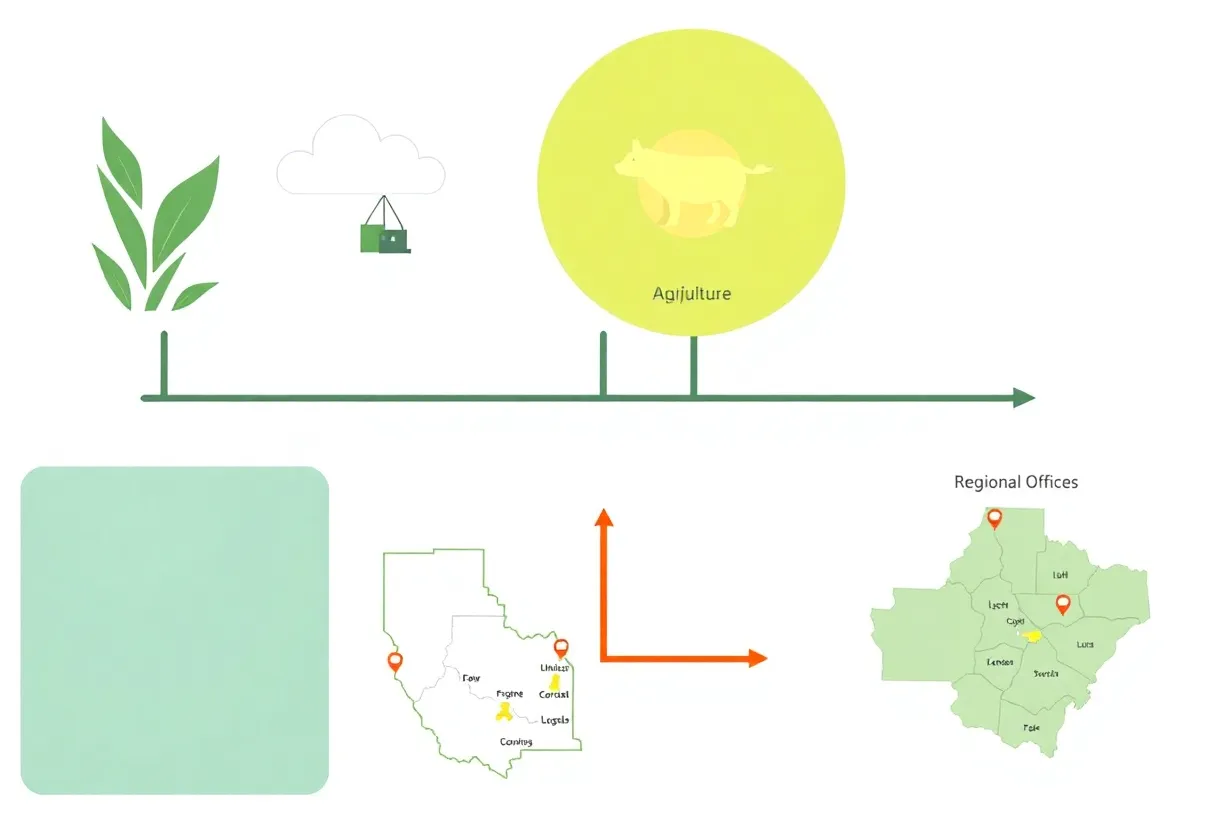News Summary
The USDA is set to relocate most of its workforce from Washington D.C. to five regional hubs across the United States. Agriculture Secretary Brooke Rollins announced this significant reorganization aimed at reducing bureaucracy and cutting costs. Key offices in D.C. will close while staff will move to Salt Lake City, Fort Collins, Indianapolis, Kansas City, and Raleigh. Concerns have been raised regarding the impact on employee morale and oversight, while the move is expected to save taxpayer money due to lower salary costs outside the capital.
USDA Goes for a Big Change: Staff Moving to Regional Hubs
In a major shake-up for the United States Department of Agriculture (USDA), Agriculture Secretary Brooke Rollins has revealed plans for a significant reorganization aimed at moving the bulk of the USDA’s workforce out of Washington D.C. and into five regional hubs across the country. This is quite the shift and it’s bound to impact how the USDA operates.
What’s Happening?
The plan will see most of the USDA’s staff in the Washington area relocate to five selected cities: Salt Lake City, Fort Collins (Colorado), Indianapolis, Kansas City (Missouri), and Raleigh (North Carolina). Nearly all offices in the D.C. area will close after the transition, except for a couple of buildings situated on the National Mall. This includes the well-known Whitten and Yates buildings.
A Shrinking Capital Presence
Several key USDA facilities will be affected, with closures announced for major locations like the South building of USDA’s headquarters, the Beltsville Agricultural Research Center, the George Washington Carver Center, and a Food and Nutrition Services facility in Alexandria, Virginia. While the USDA is not planning a significant reduction in its workforce overall, it has already seen over 15,000 employees leave through a deferred resignation plan.
Why the Move?
This reorganization is not just a new chapter for USDA operations; it’s also a strategic measure aligned with the Trump administration’s goals of cutting unnecessary spending and trimming down what it sees as a bloated bureaucracy within federal agencies. A recent Supreme Court ruling granted agencies the green light to go ahead with such restructures, giving this plan added momentum.
Costs and Concerns
Interestingly, more than 90 percent of the USDA’s nearly 100,000 employees already operate outside of Washington, primarily in local and regional offices. The reorganization is expected to reduce costs, as federal salary rates in the D.C. area are significantly higher — about 34 percent more than those in the new hub locations.
The Human Impact
Though Rollins asserts that critical USDA services won’t be disrupted, there are whispers of worry among USDA staff. Some employees are concerned about potential drops in morale and think this might lead to challenges in oversight and a consolidation of power among fewer people. Financial strain is also a worry, as the relocation could place significant burdens on some employees, possibly resulting in further resignations.
Looking Back
This isn’t the first time the USDA has undergone such a change under the Trump administration. Previous relocations saw notable turnover and a loss of institutional knowledge, which later required reversal efforts by the Biden administration. With this new plan, various stakeholders are voicing concerns about how it could impact USDA’s ability to deliver essential services, especially to farmers and rural communities.
A Hopeful Outlook?
While change often brings uncertainty, there is a silver lining according to some congressional Republicans who view this move as a potential opportunity to enhance USDA services for farmers and ranchers by bringing those services closer to their communities. Time will tell how it all unfolds, but the USDA is making strides toward reshaping its operational framework.
FAQ Section
What is the main goal of the USDA reorganization?
The reorganization aims to transfer most USDA staff from the Washington area to five regional hubs across the United States to reduce bureaucracy and costs.
What are the selected hub locations for the USDA staff relocation?
The selected hub locations include Salt Lake City, Fort Collins (Colorado), Indianapolis, Kansas City (Missouri), and Raleigh (North Carolina).
Will there be layoffs as part of the reorganization?
No large-scale reduction in force is planned, but the USDA has already seen a significant number of employees resign due to a previous deferred resignation plan.
Key Features of USDA Reorganization
| Feature | Description |
|---|---|
| Regional Hubs | Staff will be relocated to Salt Lake City, Fort Collins, Indianapolis, Kansas City, and Raleigh. |
| Office Closures | Most Washington-area offices, including several major facilities, will be closed. |
| Cost Savings | The move is expected to save money due to lower federal salary locality rates outside D.C. |
| Employee Impact | Concerns over morale, oversight, and potential financial burdens for relocating employees. |
| Historical Context | Previous relocations led to staff turnover that required reversal efforts. |
Deeper Dive: News & Info About This Topic
- Politico: USDA Rollins Announces Reorganization
- Brownfield Ag News: USDA Reorganization Plans
- Civil Eats: USDA Major Reorganization Announcement
- Wikipedia: United States Department of Agriculture
- Google Search: USDA reorganization

Author: STAFF HERE AUGUSTA WRITER
The AUGUSTA STAFF WRITER represents the experienced team at HEREAugusta.com, your go-to source for actionable local news and information in Augusta, Richmond County, and beyond. Specializing in "news you can use," we cover essential topics like product reviews for personal and business needs, local business directories, politics, real estate trends, neighborhood insights, and state news affecting the area—with deep expertise drawn from years of dedicated reporting and strong community input, including local press releases and business updates. We deliver top reporting on high-value events such as Arts in the Heart Festival, Westobou Festival, and Masters Week. Our coverage extends to key organizations like the Augusta Metro Chamber of Commerce and Greater Augusta Arts Council, plus leading businesses in manufacturing and healthcare that power the local economy such as Textron Specialized Vehicles, Cardinal Health, and Nutrien. As part of the broader HERE network, including HEREAtlanta.com and HERESavannah.com, we provide comprehensive, credible insights into Georgia's dynamic landscape.





